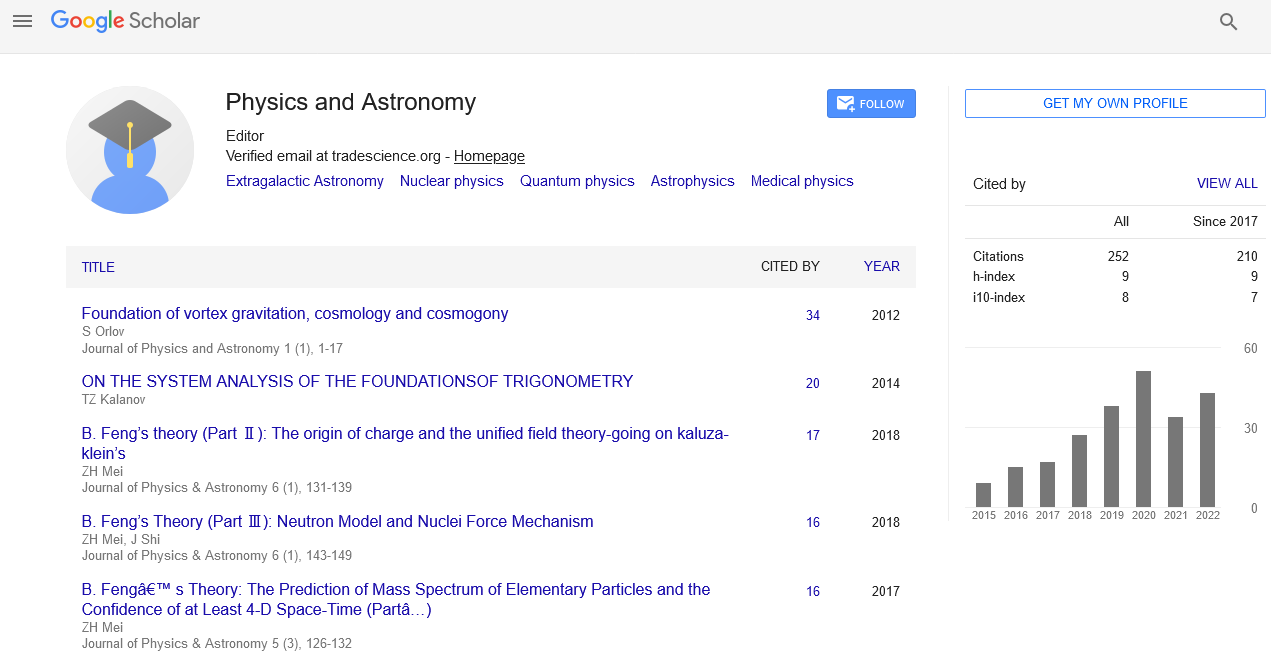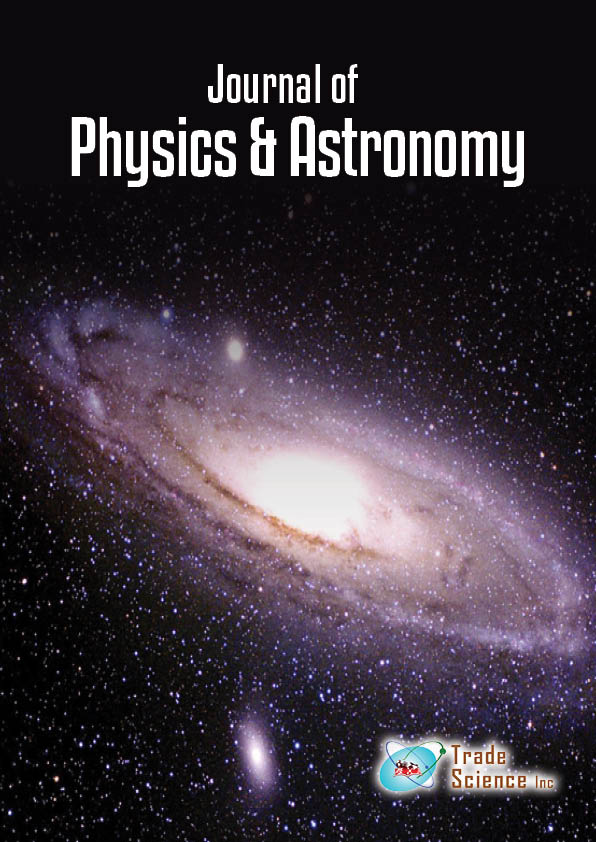Image Article
, Volume: 12( 11)Photon is Information of Address in Holographic plane
- *Correspondence:
- Bhushan Poojary
Department of Physics, NIIMS University, Jaipur, India
E-mail: bhushanpoojary@gmail.com
Received date: Nov-03-2024, Manuscript No. tspa-24-154156; Editor assigned: Nov-06-2024, Pre-QC No. tspa-24-154156(PQ); Reviewed: Nov-09-2024, QC No. tspa-24-154156(Q); Revised: Nov-14-2024, Manuscript No. tspa-24-154156(R); Published: Nov-26-2024, DOI. 10.37532/2320-6756.2024.12(11).343
Citation: Poojary B. Photon is Information of Address in Holographic Plane. J Phys Astron. 2024;12(11):343.
Abstract
Photons, the fundamental quanta of light, are widely recognized as carriers of energy and mediators of electromagnetic interactions. This paper proposes that photons also encode the "address" of quantum interactions within the holographic plane, providing a mechanism for coordinating quantum phenomena across space time. Building on the framework presented in Emergent Universe from Many Unreal World Interpretation, this hypothesis suggests that photons function as messengers of spatial and informational coordinates, offering new interpretations of wave function collapse, quantum entanglement, and delayed-choice experiments. This approach integrates the holographic principle with quantum mechanics, potentially bridging two foundational theories of modern physics.
Keywords
Photons; Quanta of light; Energy carriers; Electromagnetic interactions; Quantum interactions
Introduction
The holographic principle, rooted in black hole thermodynamics, asserts that the information describing a volume of space is encoded on its boundary [1]. This principle has inspired theoretical advances in string theory and quantum gravity. Photons, as the most fundamental particles mediating electromagnetic forces, interact universally, making them ideal candidates to encode and transmit this boundary information.
In prior work (Emergent Universe from Many Unreal World Interpretation), a framework was introduced wherein all particles are assigned unique addresses in the holographic plane. This paper extends that idea by hypothesizing that photons are the primary carriers of these addresses. By examining the quantum behaviors of photons, such as entanglement and interference, we propose that their informational role provides a coherent explanation for phenomena that challenge classical interpretations of quantum mechanics [2-6].
Theoretical Framework
Address encoding in the holographic plane
Each particle’s address in the holographic plane represents its unique identity and position in spacetime. This address can be mathematically modeled as a point on a holographic boundary surface [1,6]. For photons, the encoding of this address could manifest through:
• Phase and frequency: Variations in the photon's wave function might correspond to spatial or temporal components of theaddress [2,3].
• Polarization states: Quantum information encoded in polarization could represent the orientation of the address in higher-dimensional space [5].
Mathematical model:

where x, y,z are spatial coordinates, t is time, and θ, ? are angular parameters encoding holographic information.
Wave function collapse as address updates
When photons interact with a system, such as a detector or another particle, the interaction can be interpreted as an exchange or update of address information. The wave function collapse corresponds to the resolution of uncertainty in the photon's address [6,7]. Mathematically, this can be expressed as:

where the transition reflects the photon's updated spatial-temporal and informational coordinates.
Photon as a messenger in quantum entanglement
Entangled photons share an address in the holographic plane [4,6]. When one photon is measured, its address is updated, and this update propagates instantaneously to its entangled counterpart. This mechanism ensures consistency across spacetime without violating causality [4,5].
Connections to Experiments
Double-slit experiment
The hypothesis reframes the double-slit experiment as a process where photons project their addresses across multiple possible paths in the holographic plane. When unobserved, the photon’s address remains unresolved, resulting in an interference pattern due to the superposition of all possible paths:

where ψ1 and ψ2 are the wave functions corresponding to each slit. Observation resolves the address into one specific path, collapsing the wave function [4,6,7].
Delayed-choice quantum eraser
In this experiment, the photon’s address evolves dynamically as it traverses the setup. Entangled idler photons serve as retroactive messengers, updating the spatial address information of signal photons. This hypothesis eliminates the need for retrocausality by framing the observed patterns as outcomes of address resolution across entangled states [4].
Quantum communication
Photons transmitting address information could revolutionize quantum communication protocols. For instance, encoding addresses in photon polarization states allows for secure, high-fidelity transmission of quantum keys [5,6].
Experimental Verification
Photon address manipulation
Create experimental setups to measure whether variations in polarization or phase correspond to holographic address changes during interactions [3,5].
Entanglement correlation
Test whether entangled photon pairs exhibit measurable correlations in address-like properties beyond existing quantum entanglement parameters [4,6].
Delayed-choice adaptations
Modify the delayed-choice experiment to directly observe address encoding mechanisms, using high-precision detectors to track photon behavior before and after wave function collapse [4,6].
Implications
Quantum mechanics and information theory
This approach provides a unified framework for interpreting quantum phenomena as manifestations of holographic address dynamics. It could redefine our understanding of wave-particle duality and non-locality [6,7].
Holography and gravity
If photons carry holographic information, this could deepen our understanding of how spacetime geometry interacts with quantum fields, potentially informing theories of quantum gravity [1,6].
Quantum computing and communication
Encoding address information in photons could pave the way for new quantum technologies, such as holographic quantum networks and more secure quantum cryptography [5].
Conclusion
By hypothesizing that photons encode and transmit holographic address information, this paper bridges quantum mechanics with the holographic principle. This framework offers fresh insights into quantum behaviors such as wave function collapse, entanglement, and interference, and suggests pathways for experimental validation and technological innovation. Future work will focus on refining the mathematical formalism and conducting experiments to validate these ideas.
References
- Bekenstein JD. Bekenstein-hawking entropy. Scholarpedia. 2008;3(10):7375.
- Pathria RK. The universe as a black hole. Nature. 1972;240(5379):298-9.
- Peres A. Quantum theory: concepts and methods. Kluwer acad Publ. 1997.
- Kim Y, Choice. InEncyclopedia of Quality of Life and Well-Being Research 2024. Cham: Springer Int Publ.
- Zeilinger A. Experiment and the foundations of quantum physics. Rev Mod Phys. 1999;71(2):S288.
- Poojary BB. Emergent Universe from Many Unreal World Interpretation. Theor Phys. 2020;6(3):14-8.
- Von Neumann J. Mathematische grundlagen der quantenmechanik. Springer-Verl 2013.

